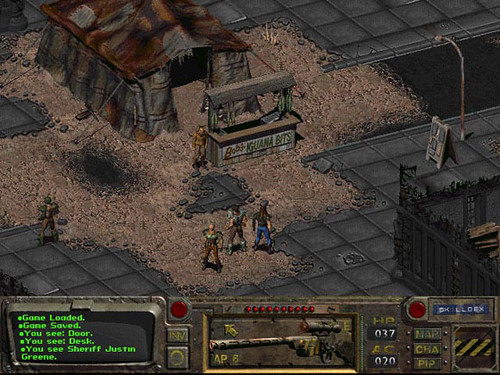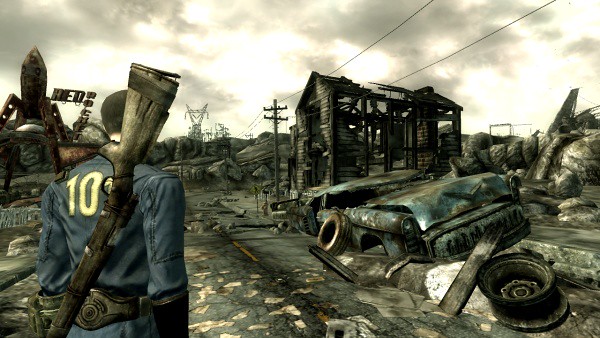Fallout: New Vegas releases later this month and though it may seem similar to Fallout 3, it’s actually a very big deal for the series. Despite the blockbuster success of Fallout 3, the series has endured a bumpier road than one might expect. Though New Vegas developer Obsidian Entertainment may be a new name to the series, the studio is actually composed of members of the original Fallout team and New Vegas is the first chance they have had to return to their series in over a decade. To get a better grasp on this, let’s get in the Wayback Machine and head back to where Fallout began, the magical year of 1997…
Fallout (1997)

Developed by Black Isle Studios and published by Interplay, Fallout was released in November 1997 to a very sparse PC RPG market. Blizzard had released Diablo at the beginning of the year…and that was about it for the genre at the time. However, Fallout distinguished itself from Blizzard’s game through its unique, retro-future setting and by offering something that very few games of the time did – choice.
Though the objective was to save the inhabitants of your underground nuclear shelter, players were free to explore the game’s setting, the atomic-fried remains of southern
For fans who entered the series with Fallout 3, the first game might be a bit unusual. As you can tell by the screenshot, the game was played from an overhead, isometric perspective instead of first-person, and combat was turn-based instead of the real-time fights of Fallout 3. The only thing that really dates the game, though, is the interface. There were three different cursors in Fallout which you cycled through by right-clicking. One of them was used to move, another to pick targets for attacks, and a third was used to interact with the environment. This was accomplished by holding down the mouse button over an object and selecting from a drop-down menu of icons, not all of which were easy to identify. It’s a system that you could get accustomed to, but not without some trial and error first.
Even with these problems, though, many people consider the first Fallout to be the best game in the series. It established the brand’s identity right from the start with its mix of dark humor, ultra violence, non-linearity and moral ambiguity, traits which have come to define the series going forward.
Fallout 2 (1998)
A sequel to Fallout was quickly released a year later, despite the departure of many key members of the team, including Tim Cain, one of the lead designers, and Leonard Boyarsky, who was responsible for the series’ distinctive visual style, including the iconic Valut Boy. Feargus Urquhart, a designer and production director from the first game, became one of the lead developers for Fallout 2.
Shipping a little less than a year after the first game, Fallout 2 barely touched the formula started by its predecessor. Its major gameplay change was improving your control over the companion characters who would tag along with you. While there were a handful of henchmen available to recruit in the first Fallout, they were often more trouble than they were worth as you were at the mercy of the decisions made by their generally brain-dead A.I. I can personally recount being killed on numerous occasions by a party member who found it much more efficient to shot her machine gun through me rather than take a step to the side. Fallout 2 fixed that by letting you set parameters for your minions such as when to use burst fire on automatic weapons and what distance to keep from you.
Aside from this, Fallout 2’s main contribution to the series was expanding the setting. Taking place about a century after the first game, Fallout 2 showed humanity starting to rebuild itself after the nuclear apocalypse. While settings in the first Fallout mainly consisted of ramshackle dwellings and ruined, pre-war buildings, Fallout 2 took players to cities rebuilt with futuristic technology and fledgling governments that Wastelanders were beginning to form. Fallout 2 also introduced the G.E.C.K., or Garden of Eden Creation Kit, to the series, which would become a major plot point of Fallout 3.
Fallout 2 did divide fans over its inclusion of several pop culture references which some felt tarnished the series’ carefully-crafted setting. In one town, a bar patron not only challenged you to a card game called “Tragic: The Garnering,” but also referenced Calvin Klein cologne. Similarly, wandering the wasteland might lead you into a random encounter with a lone bridgekeeper who demanded you answer his questions three, ‘ere the other side of the bridge you would see (and yes, you can kill him by asking a question back to him).
Other than that, Fallout 2 was very well-received and served as more of a refinement of the series’ mechanics than a revolutionary leap forward, something that perhaps New Vegas will emulate when it releases.
Fallout Tactics: Brotherhood of Steel (2001)
Fallout Tactics is where other developers began to experiment with the Fallout universe. Developed by Austrlian company Micro Forté, Fallout Tactics ditched the role-playing elements of the previous two games in favor of making a squad-based strategy game.
There’s precious little I can say about it, having only played a small amount of it myself. Reviews have been mostly positive, praising the implementation of Fallout’s character building rules, which lets you field an army using many of the same skills and perks of the previous games while adding a few new ones. Plus, it lets you recruit dogs into your army. There are still demos of it floating around on the Internet if you are interested in giving it a whirl.
Project Van Buren (The Fallout That Never Was)

Though Black Isle had made a name for itself with Fallout and subsequent titles like the Icewind Dale series and Planescape: Torment, parent company Interplay was undergoing some serious financial difficulties around the turn of the century. By 2003, Feargus Urquhart had left to form a new company, Obsidian Entertainment, and took several key Black Isle staffers with him. Later that year, the axe fell and the entirety of Black Isle’s staff was laid off. Shortly thereafter, it was revealed that Black Isle had been working on a project codenamed “Van Buren,” which was in fact a third Fallout game.
At the time of cancellation, Van Buren had left the concept stage and a tech demo had been created. As opposed to a vault dweller, the player’s character would be an escaped prisoner who gradually uncovers a conspiracy to start a second nuclear holocaust. The tech demo is still floating around the Internet, and if you’re interested in this lost bit of Fallout lore you can download the demo here from the Web site www.AtomicGamer.com.
{pagebreak}
Fallout: Brotherhood of Steel (2004)
In a desperate attempt to milk any money out of the Fallout series it could, Interplay developed and published Brotherhood of Steel, the first Fallout game for consoles. An action-RPG in the vein of console titles like Baldur’s Gate: Dark Alliance and Champions of Norrath, the best thing critics had to say about Brotherhood of Steel was that it was unoriginal. Other critics called it a soulless cash-in, and an insult to the series’ legacy.
And legacy was pretty much all the series had to go for it at this point as Interplay was broke. The year 2004 saw the company being evicted from its offices and selling off as much intellectual property as it could to stay afloat. This included hocking the rights to Fallout 3 to Bethesda Softworks, creators of The Elder Scrolls RPG series. Interplay itself promised to make money off of a Fallout MMO, and proceeded to promise they were still working on it for the next six years. After everything the Fallout franchise had been through, many gamers of the time feared Fallout 3 would meet a similar fate…
Fallout 3 (2008)

Thankfully, we live in the future where things are awesome. As Fallout 3 crept closer to an actual release date, some fans were shocked at the changes
With Fallout 3,
Fallout is a series with a troubled history, but under
And Interplay? Well, maybe they’ll get that Fallout MMO out before the bombs drop…